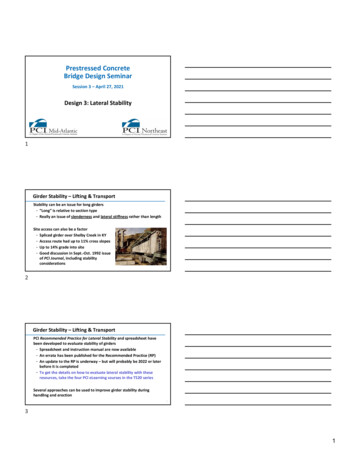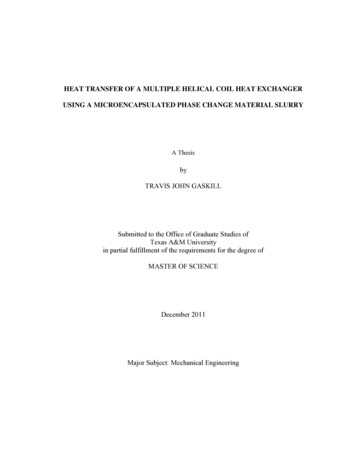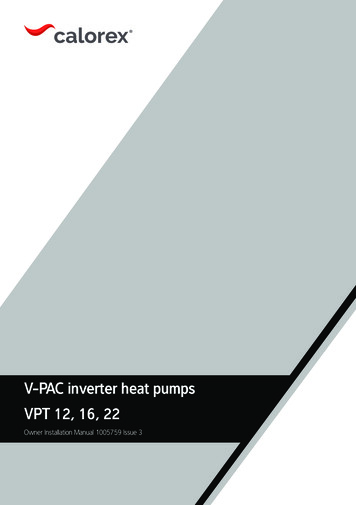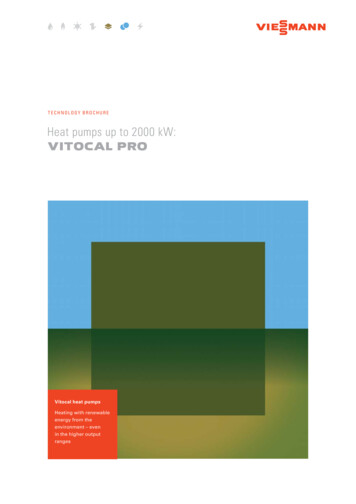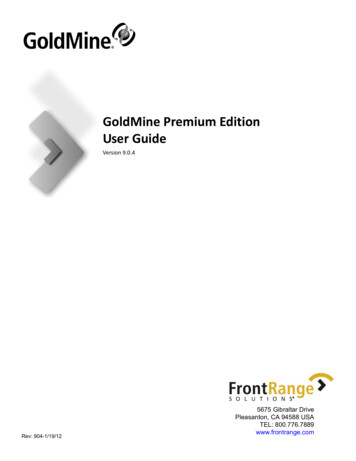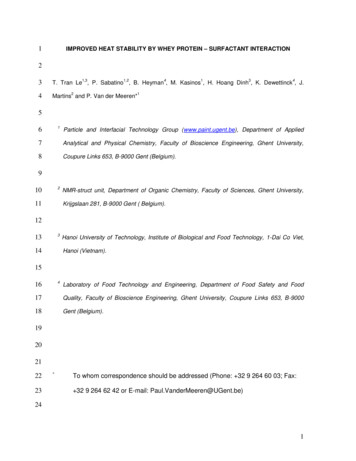
Transcription
IMPROVED HEAT STABILITY BY WHEY PROTEIN – SURFACTANT INTERACTION121,31,241343T. Tran Le , P. Sabatino , B. Heyman , M. Kasinos , H. Hoang Dinh , K. Dewettinck , J.4Martins and P. Van der Meeren*21516Particle and Interfacial Technology Group (www.paint.ugent.be), Department of Applied7Analytical and Physical Chemistry, Faculty of Bioscience Engineering, Ghent University,8Coupure Links 653, B-9000 Gent (Belgium).921011NMR-struct unit, Department of Organic Chemistry, Faculty of Sciences, Ghent University,Krijgslaan 281, B-9000 Gent ( Belgium).1231314Hanoi University of Technology, Institute of Biological and Food Technology, 1-Dai Co Viet,Hanoi (Vietnam).15416Laboratory of Food Technology and Engineering, Department of Food Safety and Food17Quality, Faculty of Bioscience Engineering, Ghent University, Coupure Links 653, B-900018Gent (Belgium).1920212223*To whom correspondence should be addressed (Phone: 32 9 264 60 03; Fax: 32 9 264 62 42 or E-mail: Paul.VanderMeeren@UGent.be)241
1Abstract23One of the main changes that occur during heat treatment of milk is whey protein denaturation,4which in its turn may lead to protein aggregation and gelation. In this contribution, the effect of5lysophospholipids, the main components of lysolecithins, as well as alternative surfactants, on6heat-induced whey protein aggregation has been studied. Hereby, attention was paid to the7relation between polar lipid molecular structure (e.g. effect of alkyl chain length, effect of polar8head group) and heat stabilising properties. Residual protein determination in the supernatant9obtained after centrifugation of heated whey protein solutions learned that whey protein10aggregation was at least partly prevented in the presence of surfactants. As the short alkyl chain11lysophospholipids were particularly effective heat stabilisers, hydrophilic surfactants seemed to12be most effective, which may be ascribed to their higher critical aggregation concentration. Upon13more severe heat treatment, protein aggregation was probed either in-situ by oscillatory rheology,14or ex-situ by yield rheometry. As some surfactants significantly reduced the gel strength, or even15prevented heat-induced gel formation, these experiments corroborated the heat-stabilising effect16of hydrophilic surfactants. Nuclear Magnetic Resonance (NMR) enabled a more direct evaluation17of the protein-surfactant interaction. A strong hydrophobic interaction between small molecular18weight surfactants and whey proteins became obvious from the chemical shift of the surfactant19hydrophobic groups in the NMR spectrum and could be quantified by pulsed field gradient NMR20(pfg-NMR) diffusiometry. The results indicated that protein-surfactant interaction did not occur21upon thermal denaturation, but already took place at room temperature. However, the effect of22this interaction became mainly obvious during thermal treatment.23Overall, this work indicated that bound surfactants largely minimise heat-induced protein24intermolecular interactions and hence prevent heat-induced protein aggregation. As the25surfactant molecular structure plays a decisive role, it follows that the heat stability of whey26protein containing products may be optimised by appropriate selection of ingredients such as27(lyso)phospholipids.2
12Key words: Whey protein isolate (WPI), heat coagulation, lysophospholipids, surfactants, NMR,3rheology3
11. Introduction23Heat treatment of milk leads to numerous changes in its chemical and physical properties. An4extreme change is heat coagulation, a phenomenon in which heat-induced serum protein-casein5interactions play an important role (Fox, 1981; Fox, 2003; Jeurnink and de Kruif, 1993; Van der6Meeren, El-Bakry, Neirynck & Noppe, 2005). Although the exact mechanism of this undesired7effect is not yet fully understood, still it is known that heat-induced whey protein interactions play8an important role (Brown, 1988; Havea, 1998; Havea, Carr & Creamer, 2004). Upon heating β-9lactoglobulin, the major whey protein, at neutral pH conditions to 70 C, dimers first dissociate into10monomers, and a thiol group as well as hydrophobic residues become solvent accessible.11Subsequently, aggregates are formed via intermolecular thiol-disulphide exchange, thiol-thiol12oxidation and noncovalent interaction (Hoffmann and van Mil, 1997; McSwiney, Singh,13Campanella & Creamer, 1994; Mulvihill and Kinsella, 1987). This may lead to heat-induced14gelation of whey protein.15A number of studies have shown that lecithins may overcome undesirable heat coagulation16effects upon severe heating (Hardy, Sweetsur, West & Muir, 1985; McCrae, 1999; Tran Le, El-17Bakry, Neirynck, Bogus, Hoa & Van der Meeren, 2007; Van der Meeren et al., 2005; van18Nieuwenhuyzen and Szuhaj, 1998). In addition, the effect of hydrolyzed lecithin on the19characteristics of thermally induced protein gels and protein stabilized emulsion gels has been20reported. Thus, Jost, Dannenberg and Rosset (1989) showed that introducing hydrolysed lecithin21before or during emulsification reduced substantially the strength of a heat-set whey protein22emulsion gel. Dickinson and Yamamoto (1996a), on the other hand, indicated that addition of23pure egg-yolk L-α-phosphatidylcholine after emulsification caused an increase in strength of a24heat-set25interaction is important to better understand the heat-stabilising properties of lecithin.26Interestingly, lecithin is only one type of low molecular weight surfactant. The interaction between27whey proteins and low molecular weight surfactants has been extensively investigated by-lactoglobulin emulsion gel. Therefore, the investigation of whey protein-lecithin4
1Goddard and Ananthapadmanabhan (1993), Chen and Dickinson (1995), Dickinson and Hong2(1995), Chen and Dickinson (1998), Chen, Dickinson, Langton & Hermansson (2000) as well as3Roth, Murray & Dickinson (2000). A general model proposed to explain how anionic surfactant4interacts with globular whey proteins has been suggested. According to Jones (1992) and Oakes5(1974), three successive mechanisms may occur upon increasing the surfactant concentration,6i.e. specific binding at low surfactant concentration, non-cooperative binding at higher surfactant7concentration and cooperative binding at still larger concentration. Giroux and Britten (2004)8indicated that the formation of protein-anionic surfactant complexes depends on the surfactant9concentration, pH, ionic strength and temperature.10The aim of this study was to investigate the effect of hydrolysed lecithin on whey proteins during11heat treatment. Whereas some effects may occur on the molecular level (leading to changes in12protein conformation and/or its temperature dependence), our study focused on surfactant effects13on (the prevention of) whey protein aggregation. Hereby, it is important to mention that whey14protein gelation strongly depends on the electrolyte composition (Bryant & McClements, 2000). In15order to ensure pH and ionic strength conditions that are representative for milk, a calcium-16containing imidazole buffer was selected in all our experiments. For comparative purposes, the17effect of hydrolysed soybean lecithin was compared to that of pure lysophospholipids, anionic18surfactants, nonionic sucrose esters and POE-based nonionic surfactants. Oscillatory rheology19was preferred for the in-situ determination of the effect of heating and subsequent cooling on20whey protein solutions, whereas vane spindle rheometry enabled the ex-situ characterisation of21the gels formed. Chemical analysis of the supernatant obtained by centrifugation of moderately22heated whey protein solutions enabled the quantification of the residual amount of soluble whey23proteins, as well as surfactants. Finally, Nuclear Magnetic Resonance (NMR) was used to study24the whey protein-surfactant interactions into more detail.5
12. Materials and methods22.1. Materials3Whey protein isolate (WPI) was obtained from Davisco Foods International, Inc. (BiPRO , Le4Sueur, MN, USA). Kjeldahl analysis revealed that this minimally heat-treated WPI contained592.6% of protein, whereas polyacrylamide gel electrophoresis (PAGE) indicated that6approximately 85% of the total protein consisted of7incineration at 525 ºC) and 5.0% moisture (from weight loss at 102 ºC) and 0.8% fat.8Hydrolyzed soybean lecithin (Emultop HL50 IP) was obtained from Cargill Texturing Solution9(Germany). According to the manufacturer, this hydrolyzed lecithin contains 95% acetone-lactoglobulin. It contains 1.6% ash (by10insolubles, 14% phosphatidylcholine, 8.5% lysophosphatidylcholine, 2% moisture and 3% oil.11Three different lysophosphatidylcholine (LPC) products were purchased from Anatrace (USA): e (C14-LPC; MW 467.58 g/mol; CMC 0.03613mM), 1-palmitoyl-2-hydroxy-sn-glycero-3-phosphocholine (C16-LPC; MW 495.64 g/mol; CMC 140.0032 mM) and 1-stearoyl-2-hydroxy-sn-glycero-3-phosphocholine (C18-LPC; MW 532.6915g/mol), in which the purity was over 99% (by HPLC analysis).16Sodium dodecylsulfate (SDS; MW 288.38 g/mol; CMC 8.3 mM), sodium laurate (Na-laurate,17MW 222.3 g/mol; CMC 27.8 mM), Tween 20 and Brij78 originated from Sigma-Aldrich Logistik18GmbH (Germany), whereas Tween 80 was obtained from ICI surfactants (Belgium). Three sugar19ester products of Ryoto sugar ester (Mitsubishi-Kagaku food corporation, Japan) were used:20sucrose palmitate (P-1570), sucrose oleate (OWA-1570), as well as sucrose laurate (LWA-1570)21in which 70% pure palmitic acid, oleic acid and lauric acid are present, respectively.22Ca-imidazole buffer containing 20 mM imidazole, 5 mM CaCl2.H2O, 30 mM NaCl and 1.5 mM23NaN3 was prepared according to Anema (1997). Its pH was adjusted to 6.55 by 1N HCl. This24buffer was selected to have an electrolyte composition that resembled dairy products.25262.2. Oscillation rheological measurements6
1An AR2000 Rheometer (TA instruments, Belgium) equipped with a 28 mm conical concentric2cylinder measuring system was used in all experiments. An amount of 20 ml of a mixture of equal3volumes of whey protein (5.5%) and surfactant (2%) solution in Ca-imidazole buffer was poured4gently into the cup and covered by aluminium foil to prevent water evaporation during the5experiment. Gels were formed by heating the samples from 20 to 80 C at a constant rate of62 C/min, holding at 80 C for 15 minutes, and cooling to 20 C at a constant rate of 2 C/min.7Measurements were taken at a frequency of 1 Hz and at a strain of 0.002. A preliminary strain8sweep at a frequency of 1 Hz indicated that the linear visco-elastic region of a 2.75% whey9protein isolate gel in the absence of surfactants extended up to about 10%.10Yield stress measurements were performed using a YR-1 Yield Rheometer (Brookfield, USA) with11vane spindle 73. The EZ-Yield V 1.0 software was used to fix the parameters of the spindle and12to transfer data from the rheometer to the computer. The parameters were set as follows: zero13speed 0.01 rpm, run speed 0.03 rpm, and torque reduction 110 %. An amount of 16 ml of14a mixture containing equal volumes of WPI solution (5.5%) and hydrolysed lecithin solution (2%)15in Ca-imidazole buffer was transferred into a glass tube with a diameter of 20 mm and a length of1680 mm, before heating at 80 C for 5, 10 or 15 minutes, and immediately cooled down in water at17room temperature. The 4-bladed spindle was slowly inserted into the sample tube, to a point that18the top of the gel is at the same height as the primary immersion mark.19202.3. Residual solubility21One ml of 5.5% (w/v) whey protein stock solution was mixed with either 0.0 or 1.0 ml of 2% (w/v)22of either hydrolysed lecithin or alternative surfactant stock solutions, all in Ca-imidazole buffer.23After adjusting the total volume to 2 ml with Ca-imidazole buffer, the mixture was heated for 0, 124and 2 minutes in a water bath at 80 C and then cooled with tap water at room temperature. All25heated samples were centrifuged for 15 minutes at 2900 g in a Labofuge GL (Heraeus)26centrifuge.27The residual protein content present in the supernatant was determined based on the colorimetric7
1method of Schacterle and Pollack (1973) by spectrophotometry using a PerkinElmer Lamda 352UV-spectrophotometer at a wavelength of 650 nm. The residual phospholipid (PL) content of the3samples containing LPCs was determined by colorimetric phosphate analysis after acid digestion4(Van der Meeren, Vanderdeelen & Baert, 1988) at a wavelength of 820nm. The total organic5carbon (TOC) content in mixtures containing alternative surfactants was determined by an Anatoc6series II SGE Total Organic Carbon Analyser (Singapore).782.4. NMR measurement9Protein-free samples with the following concentrations were prepared: 5 mg/ml of surfactant and105 mM of sodium acetate trihydrate (MW 136.08 g/mol; Normapur) in D 2O (Armar Chemicals 99.811atom % D). In addition, whey protein containing samples (1 for each surfactant in the presence of12protein) with the following concentrations were prepared: 5 mg/ml of surfactant, 10 mg/ml of WPI13and 5 mM of sodium acetate trihydrate in D2O. Sodium acetate was used as internal standard. All14the NMR measurements were performed by a Bruker spectrometer operating at a H frequency of15500.13 MHz. The samples were analyzed twice at a temperature of 25 C, i.e. before and after a16heating/cooling process. In the latter case, the samples were heated at 80 C for 15 minutes in a17water bath and subsequently cooled down at 25 C.18Diffusion coefficients were measured by pulsed field gradient NMR (abbreviated as pfg-NMR)19with a convection compensated double-stimulated-echo experiment using monopolar20smoothened square shaped gradient pulses and a phase cycle modified according to Connell21et al. (2009). The echo-decay of the resonance intensity obtained with the double stimulated22echo sequences obeys equation (1), from which the diffusion coefficient (D) is derived as a23function of the parameter k. A detailed description of the pfg-NMR method and the24sequences mentioned above is given in a review written by Johnson (1999):125I/I exp{-D (2627GI/I exp(-D k)s)2’}[1]I echo intensity with gradient8
1I0 echo intensity at zero gradient2 gyromagnetic ratio3G gradient amplitude4s gradient shape factor (here 0.9)5 duration of the gradient pulse6’ diffusion delay corrected for the finite gradient pulse duration ( ’ – 0.602 )7The determination of the diffusion coefficient was based on the fitting of a mono -exponential8curve to the echo-decay of the peak integral as a function of k; the latter was varied by9variation of the gradient amplitude within a range going from 2% to 95% of the maximum10gradient strength (i.e. 56.1 G/m) while keeping all other parameters constant . The11determination coefficient (r ) was at least 0.90 for the (less intense) protein signals, and at12least 0.999 for both SDS and sodium laurate.29
13. Results and discussion23.1. Effect of hydrolysed lecithin on WPI gelation3Oscillatory rheology is a powerful tool for monitoring protein gelation and has been utilized in4studying the effect of surfactants on heat-induced gelation properties of β-lactoglobulin by Chen5and Dickinson (1995), Dickinson and Hong (1995), Dickinson and Yamamoto (1996a; b), Chen6and Dickinson (1998), Chen et al. (2000), as well as Roth et al. (2000). Figure 1 shows the7change in the rheological properties of a 2.75% (w/v) WPI dispersion in Ca-imidazole buffer at pH86.55 alone and in the presence of 1 % (w/v) of either hydrolysed lecithin or some alternative low9molecular weight surfactants. The gelation curves are shown in Figure 1 by the behavior of the10complex modulus, G*, as well as the phase angle, through the different temperature stages. The11heat-induced gelation behavior of WPI in Ca-imidazole buffer in the absence of surfactants is12shown by gelation curve (1) in Figure 1A. Previous studies of Bowland, Foegeding & Hamann13(1995), Clark, Kavanagh & Ross-Murphy (2001), de La Fuente, Singh & Hemar (2002) and Singh14& Havea (2003) explained that the formation of heat-induced whey protein gels is irreversible15mainly due to disulfide bridges and hydrophobic interaction. Figure 1B revealed that the phase16angle largely dropped at a temperature of 76 C, which is a clear indication of the transition from17a fluid to a gel state.18Gelation curve (2) in Figure 1A shows that hydrolysed lecithin addition to the WPI solution19decreased the complex modulus G* significantly, both in the heating and cooling period. That20means that the consistency of the WPI gel was reduced when hydrolysed lecithin was added.21This heat-protecting effect is consistent with the results of DSC measurements performed by Van22der Meeren et al. (2005) who found that hydrolysed lecithin addition shifted the denaturation23temperature of the whey proteins (74.4 C) to a higher point, by about 7 C (to 81.1 C). This shift in24denaturation temperature is also obvious from the phase angle data in Fig1B: whereas the phase25angle became less than 45 degrees at 76 C for the WPI without lecithin, this drop only occurred26at 80 C in the presence of lecithin. The question may arise whether the lower complex modulus27in the presence of lecithin is (at least partly) due to the upward shift in denaturation temperature10
1which might result in limited protein denaturation at the gelation temperature (i.e. 80 C) used. To2answer this question, oscillatory measurements were repeated using a (similar) temperature3program going up to 90 C (to ensure that the gelation temperature was above the denaturation4temperature) with 2.75% of WPI in the absence and presence of 1% of lecithin (results not5shown). Also in this case, the complex modulus of the gel formed in the absence of lecithin was6more than twice the value obtained in the presence of lecithin.7The lower complex modulus observed in the presence of lecithin (Fig.1A) is in contradiction with8the results of Ikeda and Foegeding (1999a; b) who reported that adding lecithin had an increasing9effect on the rheological properties of heat-induced WPI gels at low to moderate electrolyte10concentrations. Only in the presence of 500 mM NaCl, a smaller value of the storage modulus11was observed in the presence of lecithin in their experiments. According to our opinion, the12difference between our results and those obtained by Ikeda and Foegeding (1999a) may be13mainly ascribed to the concentrations used. In fact, Ikeda and Foegeding (1999a) used samples14containing 10% of WPI to which either no or 10% of lecithin was added. This means that the15water content was only 4 times larger than the combined protein and lecithin content, and hence16water limitation is highly probable. Under these conditions, addition of more water-binding17material will logically increase the rheological properties. On the other hand, our experiments18were based on 2.75% of WPI in the absence or presence of 1% of lecithin, which means that the19water to solute ratio is at least 96.25 over 3.75, which is equal to about 26. Under these20conditions, much more water is available and the rheology will be much more affected by the21number and strength of the interactions between the protein molecules within the gel. In fact, the22salt effect observed by Ikeda and Foegeding (1999a) also provides an indication for the23importance of the availability of water. As the water binding properties of both proteins and polar24lipids are known to decrease with increasing salt content, it follows logically that salt addition will25reduce the water limitation and hence may induce a transition from a gel reinforcing to a gel26weakening effect of added lecithin.27An alternative and simpler method to characterise the rheological properties of WPI gels is to28determine the yield stress, which may be defined as the minimum stress required to initiate flow11
1after gel formation. In this experiment, the yield stress of a 2.75% (w/v) WPI gel in Ca-imidazole2buffer (pH 6.55), containing 0% and 1% (w/v) hydrolysed lecithin, was determined. To that end,3the stress was recorded as a function of the angular displacement of the vane spindle (Figure 2).4As long as the material behaved as an elastic solid, the stress increased steadily with the5rotational angle. The slope of this part is proportional to the elastic modulus of the gel. As the6stress increases, a point is reached at which the gel network cannot withstand the exerted stress7anymore and the gel starts to flow. From this point onward, the stress decreases due to an8increasing gel breakdown. Hence, the yield stress corresponds to the maximum in the stress9versus strain curves, as shown in Figure 2. It can be seen that both the elastic modulus and the10yield stress of the WPI gels increased when increasing the heating time from 5 minutes to 1511minutes. The presence of 1% hydrolysed lecithin significantly reduced the elastic modulus and12the yield stress of WPI gels for each heating time. Hence, these ex-situ measurements are13completely in line with the results of the in-situ measurements by oscillatory rheology.14In conclusion, the rheological results in Figure 1 and 2 show that the presence of lecithin reduced15the strength of the whey protein isolate gel. Hence, both in-situ and ex-situ characterisation of16WPI gels clearly indicated the heat stabilising effect of lysolecithin. According to Van der Meeren17et al. (2005), this may be explained from the fact that hydrolysed lecithin largely reduced18attractive protein-protein interaction during heating.19203.2. Effect of alternative surfactants on WPI gelation21In order to check whether the observed effect is specific for phospholipids, some alternative22surfactants were tested. They were divided into two main groups, i.e. anionic surfactants and23nonionics. Hereby, sucrose esters of lauric, palmitic, and oleic acid, as well as polyoxyethylene24(POE)-based nonionic surfactants (Tween 20, Tween 80 and Brij 78) were selected. The effect of25the surfactants on the heat-induced whey protein isolate gels is quantified by the change in the26complex modulus (G*) during heating and cooling. The gelation curves (3-7) of samples27containing WPI and surfactants were compared to the gelation curves in the absence (1) and12
1presence of lysolecithin (2) in Figure 1. The results from Figure 1 show that a significant2difference in the gelation curves occurred by adding surfactants. The presence of both ionic3surfactants SDS and sodium laurate strongly affected the effect of heating on whey protein isolate4solutions: in fact, no gelation occurred when adding these anionic surfactants (Figure 1, curve 35and 4). The effect of sodium laurate is in line with the results of the heat stability experiments on6β-lactoglobulin by Puyol, Perez, Peiro & Calvo (1994): using differential scanning calorimetry7(DSC), they concluded that the binding of fatty acids to β-lactoglobulin may be an important factor8in the thermal stabilization of this protein. Considering ovalbumin, Mine, Chiba & Tada itheitherfattyacidsor10lysophosphatidylcholine (but not with egg phosphatidylcholine). For the sake of completeness, it11can be mentioned that Ikeda, Foegeding & Hardin (2000) observed enhanced β-lactoglobulin gel12formation upon fatty acid addition, with oleate and palmitate even inducing gelation during protein13hydration at room temperature. However, these experiments were done using 12% of protein and1412% of fatty acid so that water limitation was very probable in the latter experiments.15Visual observation learned that gelation occurred in a sample containing 2 ml of 2.75% (w/v)16whey protein isolate solution after heating at 80ºC for 2 minutes. However, a low viscosity17transparent liquid in resulted upon heating a mixture a 2.75% WPI and 1% SDS, from which it18may be deduced that there was no aggregation in the presence of SDS. Similarly, only small19aggregates were formed in samples containing 1% sodium laurate resulting in a slightly turbid,20but still very liquid-like aspect. The lower turbidity of the SDS-containing WPI solution indicated21that the heat-stabilising effect of SDS on the whey protein isolate solution was stronger than that22of sodium laurate.23Gelation curves (5), (6) and (7) in Figure 1 show that POE-based non-ionic surfactants, in24comparison to lecithin, had an increasing effect on the complex modulus of the WPI gels. Addition25of POE-based non-ionic surfactants had only a minor (for Tween 20) to no discernible effect (for26Tween 80, as well as Brij 78) on the WPI gels, compared to the corresponding sample containing27whey protein isolate without lecithin. The behaviour of these surfactants is known to be highly28temperature dependent. In fact, POE-based non-ionic surfactants are known to become less13
1hydrophilic upon increasing the temperature. The resultant surfactant clouding is expected to2badly affect the protein thermal stability. In order to overcome this complicating effect, fatty acid3sucrose esters were investigated as alternative non-ionic surfactants (data not shown). However,4these non-ionics also yielded only a small beneficial effect (in the case of lauric ester) or even a5small deteriorating effect (in the case oleic ester). Hence, the effect of the addition of 1%6surfactant on the complex modulus of heat-induced WPI gels has the following order: anionic7surfactants lysolecithin POE-based nonionic surfactants sucrose esters.8In conclusion, the addition of lecithin has a more pronounced weakening effect on heat-induced9whey protein isolate gels as compared to other surfactants, except from anionic surfactants that10even prevented the formation of heat-induced whey protein isolate gels. Hence, protein heat-11stabilising properties are not limited to phospholipids but also occur with other surfactants. More12precisely, the sodium salts of fatty acids are relevant since commercially available hydrolysed13lecithins not only contain lysophospholipids, but mostly also contain the fatty acid salts released14upon phospholipase treatment.15163.3. Effect of surfactants on whey protein aggregation17In an attempt to elucidate the interactions of whey proteins with the different above-mentioned18surfactants, two series of experiments were performed using mixtures of whey protein isolate with19surfactants in imidazole buffer that were heated for either 1 or 2 minutes at 80ºC and20subsequently cooled down by tap water. After centrifugation for 15 minutes at 2900 g, the21residual protein in the serum was determined. In order to estimate the residual surfactant22concentration, the total organic carbon content of the serum was determined as well. Prior to23measurement of the protein and total organic carbon content, the samples had to be diluted to a24suitable concentration within the measurable range: the samples were diluted 250 times in Ca-25imidazole buffer (pH 6.55) for protein determination and 400 times with distilled water for TOC26analysis, respectively. Figure 3 shows that upon heating, the whey protein isolate as well as the27total organic carbon recovery in the supernatant was significantly reduced. The residual protein14
1solubility and amount of total organic carbon of samples containing 1% lysolecithin were roughly2twice the values found for the sample without lecithin. In the presence of the ionic surfactants3(SDS and sodium laurate), the residual whey protein as well as the total organic carbon content4was hardly affected even after 2 minutes of heating. The prevention of whey protein aggregation5explains why the complex modulus G* of the samples containing 1% ionic surfactant remained6negligibly small in Figure 1.7The higher residual protein content in the supernatant upon heating in the presence of Tween 808is in line with the heat-protecting effect on bovine serum albumin of this surfactant described by9Arakawa and Kita (2000). According to these authors, this stabilising effect was due to the fact10that Tween 80 addition before heating reduced aggregation and increased the monomer content.11Considering the non-ionic surfactants, the total organic carbon content in the aqueous phase is12less reduced as compared to the protein content. This effect is especially pronounced for the13POE-based non-ionics and indicates that the surfactant recovery after heating is higher than the14protein recovery. This may either indicate that only part of the surfactant is protein bound and/or15that especially complexes with a higher protein to surfactant ratio are precipitated.16173.4. Effect of lysophospholipid molecular structure on whey protein aggregation18The heat stabilisation properties of three different molecular species of lysophosphatidylcholine19(LPC) were compared. Visual observation revealed that gelation was prevented in tubes20containing 2 ml of WPI (2.75% w/v) solution in the presence of 1% LPC after heating for 221minutes at 80 C. In fact, a highly turbid, but still flowable coagulum was obtained in the presence22of 1% LPC, as well as in the presence of 1% soybean lysolecithin. The turbidity is an indicator of23severe aggregation in all samples. Whereas large visually observable aggregates were mostly24formed, only small aggregates were formed in the mixture containing C14-LPC.25The recovery of proteins and phospholipids in the supernatant after centrifugation of unheated26and heated WPI (2.75% w/v) solutions in the absence and presence of 1% (w/v) hydrolysed27lecithin or three different kinds of LPC is shown in Figure 4 (A). The results from Figure 4 show15
1that the soluble protein content was reduced in the supernatant of all samples by increasing the2heating time. This reduction is due to aggregation and subsequent precipitation in the centrifugal3field. However,
1 An AR2000 Rheometer (TA instruments, Belgium) equipped with a 28 mm conical concentric 2 cylinder measuring system was used in all experiments. An amount of 20 ml of a mixture of equal . 10 Yield stress measurements were performed using a YR-1 Yield Rheometer (Brookfield, USA) with 11 vane spindle 73. The EZ-Yield V 1.0 software was used to .


